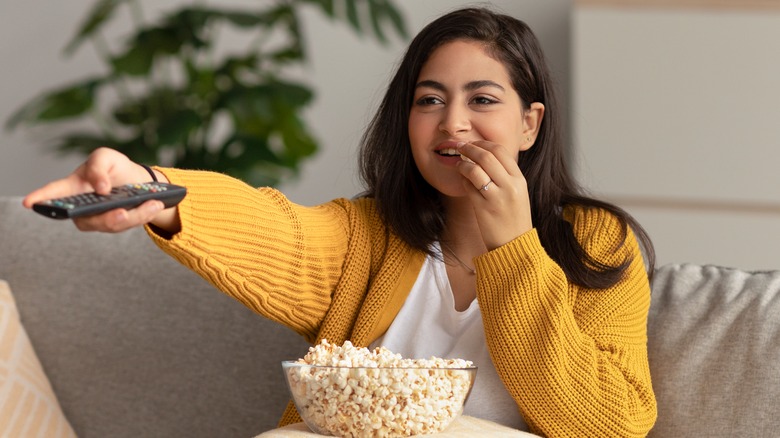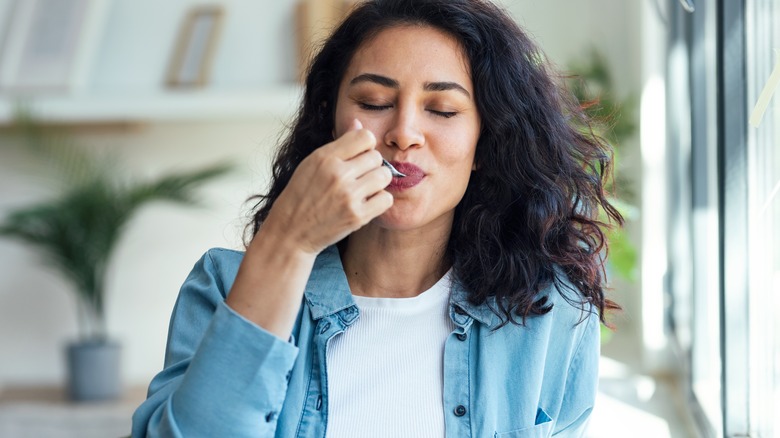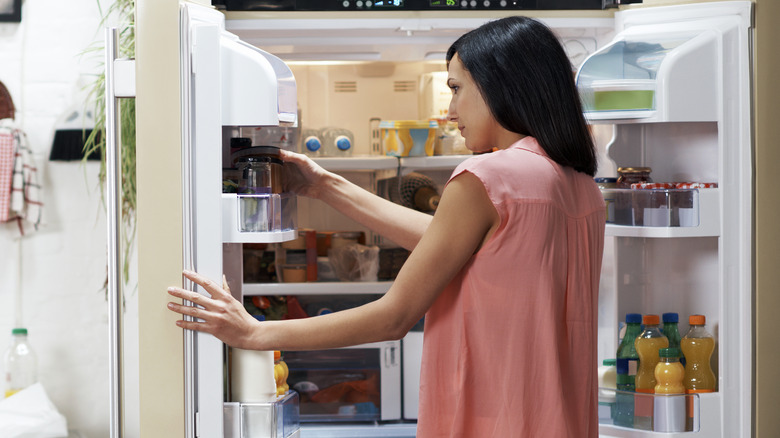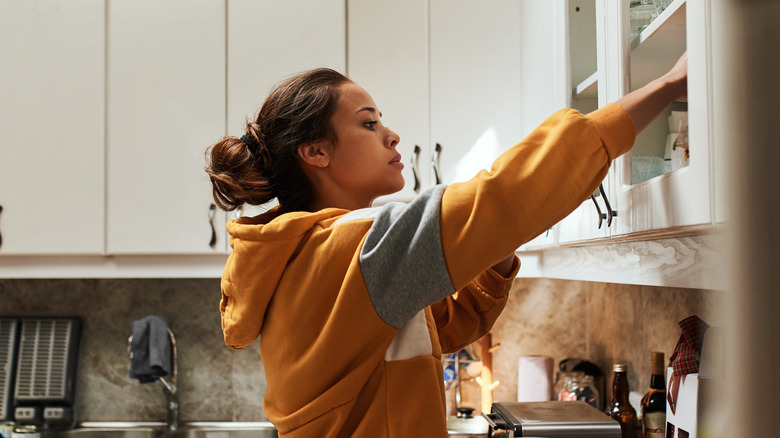17 Helpful Tricks To Beat Boredom Snacking
Mindless snacking is incredibly common. While the occasional chip or cookie is fine, it's snacking when you aren't hungry that can get you into trouble. Some may attribute it to being "hangry," while others might just be bored.
It's important not to beat yourself up over this — and helpful to understand why mindless snacking happens, whether it's an occasional thing or a more frequent issue that you'd like to quit for good.
Sometimes an unplanned snack is the result of a lack of a structured routine. When you don't follow a specific eating schedule, eating habits run amok. Or you might not be much of a cook, in which case it's easier to grab anything nearby. It could even be that you don't know what to eat for meals, so you give up and go for the snack. Once you identify the root cause, you can easily develop strategies to avoid it — and one of these may be a good starting point.
Learn to appreciate your food
Being intentional about what you eat can really make a difference, as it means you're more likely to savor each bite. Eating without thought, by contrast, might cause you to eat too fast, without much thought for the food's taste or texture.
Yet those factors can bring joy to your day! You don't have to be a foodie to appreciate the little details that make your meals special, and learning how to appreciate your food can help you snack more intelligently, too. Nutritionist Alissa Rumsey, MS, RD, explains to Women's Health, "If you eat something mindlessly, you likely don't take the time to taste and appreciate it, which means that you'll be less satisfied. So, even if you are physically full, the lack of satisfaction means you'll be more likely to seek out more food."
Take your time putting together snacks. Make something in the kitchen and become familiar with the smells, colors, and textures. Then chew slowly, enjoying every flavor and texture you experience as you eat.
Don't center downtime around food
People often mistake boredom for hunger, but a break can be a great time to fill the gap with fresh air or pet time. The important point is that you don't make food the integral part of every break, or you risk eating "just because."
"If you are snacking out of boredom, try to find an alternative activity, like reading or getting outside," advises Barbara Grossman, a clinical associate professor at the University of Georgia. Ali Berg, an assistant professor at the school as well as a Cooperative Extension nutrition and health specialist, says, "When the snacking urge starts, try an 'exercise snack' instead, such as one minute of jumping jacks, marching in place, seated punches, dancing or a lap or two around your house."
This is common for people who work from home. One way around this is to pause and take a deep breath before you eat. Rate your hunger level on a scale of one to 10. If you aren't very hungry, go for a walk instead.
Plan your snacks in advance
Planning food intake in advance can also help. If it's not in the plan, you might be less inclined to eat — and you may be more inclined to make a healthy choice for your snack.
"Planning meals and snacks ahead of time increases the chance for success, it increases the likelihood a healthier food choice will be made," explains Silvia Veri, a registered dietitian practicing at the Beaumont Weight Control Center – Canton. "If we can take the time out to plan meals, write a grocery list and have fruits, vegetables, whole grains and beans available, they will become convenient and eaten more often."
While these ingredients are more commonly linked to meals, you can easily incorporate them into snacks, too. Hummus and carrot sticks make an excellent, filling, and healthy snack. Enjoy a bowl of oatmeal topped with some dried or fresh fruit. Planning out a few snack ideas can help you be more mindful of your options and explore new worlds of healthy possibilities.
Create a physical space to snack
You'd be surprised at how easy it is to snack endlessly when you don't have a designated place to eat. Reverse the habit by choosing a place to eat snacks and plating the food. Otherwise, you might find yourself on the couch in front of the television, or in the kitchen munching on chips while browsing on your phone. Because you're distracted by other activities, you could easily lose track of where your hunger pangs end. That's a cue you should learn to recognize, because it can help you complete your snack so you don't overeat.
And when you plate your food, you can set it on a table and be more intentional about your choices. Plus, you have to be more mindful of portions when you put your snack on a plate. This is a great way to snack sensibly — without going overboard.
Do something else entirely
If you have food on the brain and take that as a cue to eat every time, you might be snacking more than necessary. It's important to recognize that being preoccupied with constant thoughts of food can be a possible sign of an eating disorder, which is why it's helpful to talk with a therapist or doctor if it's affecting your life in a significant way.
Or, you might just be stressed, which can lead you to chips or cookies as a way of coping. "Your brain needs breaks from concentration," Dr. Rachel Paul, PhD, RD, says to Eat This, Not That! "It's normal to switch your focus." Distracting yourself with another activity might help.
Go for a walk around the block with your dog or tidy up the house. Josh York, the founder of GYMGUYZ, tells Eat This, Not That!, "Perceived hunger may stem from boredom, so going for a walk or jog can help distract and entertain the mind." What to do if you can't curb your craving when you're done with your activity? That's a sign that you might genuinely be hungry.
Make a snack shopping list
Do you put much thought into what you eat for a snack? Mindless snacking is often associated with unhealthy foods like chips and cookies. The tastier and more indulgent, the more likely you'll devour your snack — and you aren't alone there.
One way to resolve this is to prepare a shopping list before you head to the store. Buying snacks can be fun when you put some effort into what you eat. It comes back to being intentional by choosing foods that benefit your body's unique needs. Plus, snacks do ultimately serve a purpose: They fill the gap in between meals and keep you satisfied while giving an energy boost.
Healthy snack ideas include fresh fruits and vegetables, nuts and seeds, pretzels, popcorn, Greek yogurt, and string cheese. All of these can be thoughtful additions to your daily diet, satiating you throughout the day and keeping you away from so-called "junk" food that might otherwise lead you to overeat.
Make sure you're eating enough during meals
Don't skimp on eating foods for breakfast, lunch, and dinner that actually nourish you. If you swap healthier options for less filling foods that aren't nutrient-rich, that could backfire and cause you to eat more during snack time, or to snack indiscriminately between meals when you normally wouldn't.
The keys are to eat the right foods at each meal and ensure that you're eating enough. If you struggle, add some protein to your day. Enjoy a few nuts daily. Spread some natural peanut butter on a slice of whole wheat toast or dip some fresh fruit into it. Incorporate healthy fats like avocado slices and fatty fish into your day.
Another way to fill up during meals is to consume enough fiber. Fiber is vital to your digestive health, helping you stay regular and keeping you full. This is also helpful if you struggle to eat enough calories during your meals. Sweet potatoes, lentils, beans, and broccoli are all excellent sources of fiber and may help you snack more sensibly throughout the day.
Learn to figure out when you're actually hungry
Are you actually hungry, thirsty, or maybe even upset or bored? It's not always easy to tell, because hunger isn't always just a feeling. There are several factors that come into play, from your body's physical processes to your emotions. Even something that's going on in your life on a particular day can have an effect on hunger.
Usually, genuine hunger will leave you with an "empty stomach" sensation. Says Dr. Janice Hillman, MD, a doctor at Penn Adolescent and Young Adult Medicine Radnor, "If you're actually hungry, you'll experience true hunger cues, such as stomach growling, low energy, shakiness, headaches and problem focusing."
By contrast, thirst typically causes the mouth to dry out. Your throat might itch, and you may have an insatiable appetite for any type of beverage. If emotions are causing your appetite to go awry, pause and reflect for a moment before you take that first bite. Think about whether you're having a tough day and whether that might have an impact on your desire to snack mindlessly. Often, this is the case!
Make snacks more like meals
You don't have to eat as much as you would during breakfast, lunch, or dinner, but treating your snacks as meals can help you focus on them more. In addition to adopting healthy habits like plating and sitting down to eat, you might also want to rethink your snacks.
This is helpful if you have a habit of eating packaged snacks that aren't healthy. Eating your snack with a spoon or fork can mean the difference between something that's good for you and a handful of potato chips. You could roast some soybeans or chickpeas and season them to give them a flavorful finish. Make homemade salsa with canned black beans, corn, and tomatoes.
Again, it comes back to being intentional with your food choices. What may not seem like a typical "snack" can absolutely pass as one if you put some effort into planning it as more of a meal than a mindless midday splurge.
Hide the naughty, bad-for-you snacks
Munching on chips and crackers "just because" is the very definition of mindless snacking. If you can relate to this, you aren't alone — and the other good news is that you can take steps to avoid this by keeping said snacks out of sight as much as possible.
There are a few ways to accomplish that, and you need to be honest with yourself about what works best for you. You could purchase the items in question less frequently and keep them tucked away, reserved only for occasional treats. You could otherwise avoid buying them altogether, in which case you'd be forced to get ready and go out to purchase them again.
If you do want to indulge in the so-called "naughty" snack, try the bowl trick. "We tend to want to eat things with our eyes," explains nutritionist Jessica Cording, RD, to Women's Health. Put a little bit of your snack in a much smaller bowl and munch on that; you'll eat less, but still feel satisfied.
Take your time when you're eating
Once you start eating mindfully, you'll realize that part of the trick is to eat more slowly. You'll feel fuller, which in turn will help you avoid mindless snacking. Of course, that can be easier said than done if you have a habit of eating quickly.
Experts recommend focusing on your chewing habits. Set a timer for a specified amount of time per snack — say, 10 or 15 minutes — and make the snack last for that duration. If you finish well before the timer goes off, you know that you probably ate too fast. Even if it seems like an inordinately long time to eat a snack, the idea is to develop the habit of chewing slowly.
It's also helpful not to snack as a substitute for a meal, something that can force you to eat faster (and therefore more) simply because you're hungrier. When you eat slowly, your brain has enough time to receive the body's signals that you're full and that it's time to stop eating.
Start buying smaller portion sizes
While you might not want to quit buying your favorite snacks altogether, you can give yourself a little challenge just by purchasing slightly smaller packages instead. Portion control is, after all, one of those sneaky "tricks" that can make all the difference in helping you avoid over-snacking — and it's a habit that is relatively easy to adopt.
It's not just smaller packages that make a difference, either. You can purchase a standard-size bag and apportion servings in plastic baggies that are ready for you to grab whenever a snack craving strikes. That will also help you avoid reaching into the larger bag for second and third helpings.
If you want to stick to a specific serving size, start using measuring cups to determine how much to put inside your plastic baggies. That's an easy way to calculate your caloric intake and stay within your daily dietary goals if you have a specific number in mind.
Limit the variety of snacks you buy
It doesn't sound very fun, but it can be very helpful to limit the variety of snacks that you buy if you have a problem with mindless snacking. In fact, studies have found that subjects tend to eat less when presented with one type of food as opposed to a variety of options.
This is an effect coined "sensory-specific satiety" for the way eating the same type of food essentially dulls your senses. By contrast, eating different types of foods and flavors prevents this numbing effect, and that can lead you to eat more than you would otherwise.
If you want to test this concept on yourself, try putting just one type of snack on your plate, or limiting it to just two instead of a wide assortment of tastes. Of course, this doesn't apply as much if you're eating a healthy snack like fruit or vegetables.
Make snacking a little bit more of a job
It's hard to avoid a snack that's right in front of you. If you make it harder to access those snacks, you'll be much less tempted to give in (or you'll need to make yourself work for it whenever temptation strikes).
A study published in the International Journal of Obesity found that proximity to snacks played a significant role in how much of the snack was consumed. People consumed more candy in the experiment when it was both visible and situated on their desk as opposed to set at a distance. So, people may be less compelled to eat if the snack isn't easy to access.
Make this work for you by putting less healthy snacks on shelves that are harder for you to reach. Don't do this with items that are better for you, however. You should always keep nuts, fruit, and other nutritious snacks within reach (and practice healthy habits, like portion control and plating, to help you manage how you eat them).
Consider snacking in the company of others
If you're snacking solo every time, you really may end up overeating when you snack. If you choose to snack with someone, especially someone who doesn't eat much or who tends to take their time eating, you may find that you snack a little bit less, too.
A 2007 study in the journal Appetite found that when women eat with companions, they tend to "match" the amount of food that their counterparts eat or eat a little bit less. Plus, when you eat with someone else, you might find that you naturally consume less food because you're busy chatting.
This forces you to take your time while you eat (even if you aren't aware of it) and focus more on communicating with your table mates instead of strictly on eating. You may even choose healthier foods for your snacks if you're with someone who maintains a generally healthy diet.
Learn all about your body's food clock
The "food clock" is a real thing that can affect when you eat. It's an interesting way of changing your diet, too. It all relates to your biological clock, or body clock, which is responsible for controlling your circadian rhythm.
Your body clock is meant to be a well-functioning machine that regulates your behaviors, including sleeping and eating. It aids in digestion and metabolization, then stops temporarily until your brain receives the signal that it's time to eat again.
You can support your internal clock by eating at the same time each day and choosing healthy foods. Limiting fat and sugar intake is vital, as your clock "reads" these signals. You might feel hungrier sooner when you consume excess sugar, for example, since it won't fill you up. That disrupts your natural clock, and you'll naturally eat more as a result. Learning what to eat and when to eat can make a big difference.
Don't be fooled by so-called healthy snacks
Don't be fooled by snacks that claim to be good for you. The "health halo" is a tactic used by manufacturers to appeal to consumers, drawing them in for a closer look with the promise of a healthier food.
Common examples are gluten-free products and snacks with so-called "superfoods" added to them, like chia, kale, and quinoa. It's true that some might be healthy, but issues like serving sizes and portion control often get in the way.
A great example is the 100-calorie snack. While popularly found on store shelves, they aren't actually "health" foods." Amy Shapiro, MS, RD, CDN, tells Well + Good, "The focus on calorie count distracts us from the low quality of the ingredients: These items are highly processed and often mostly made out of sugar or flours that will quickly convert into sugar when you eat them."

















